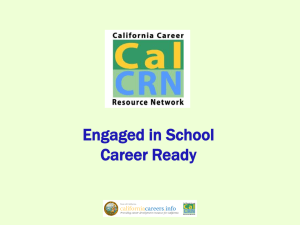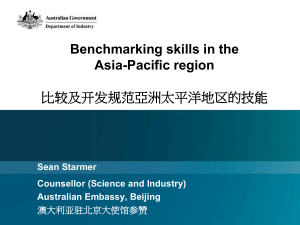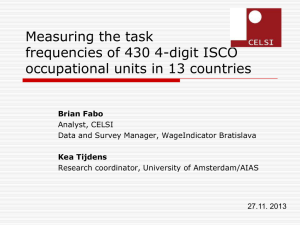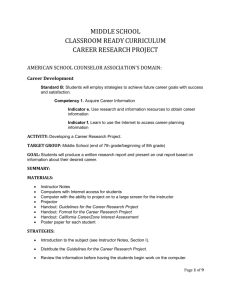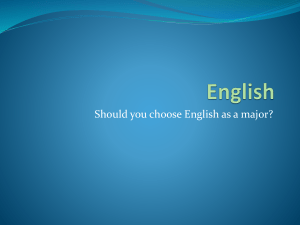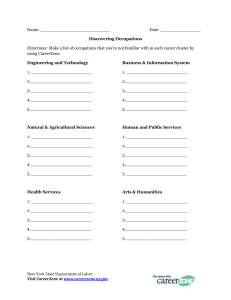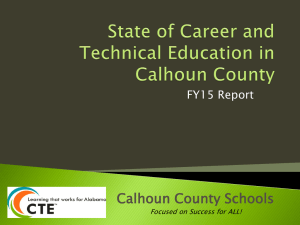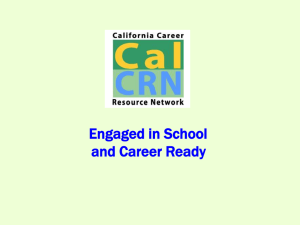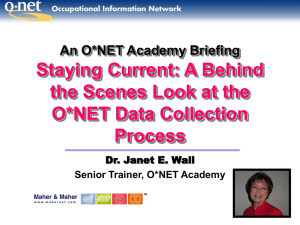DOC - California Career Resource Network
advertisement
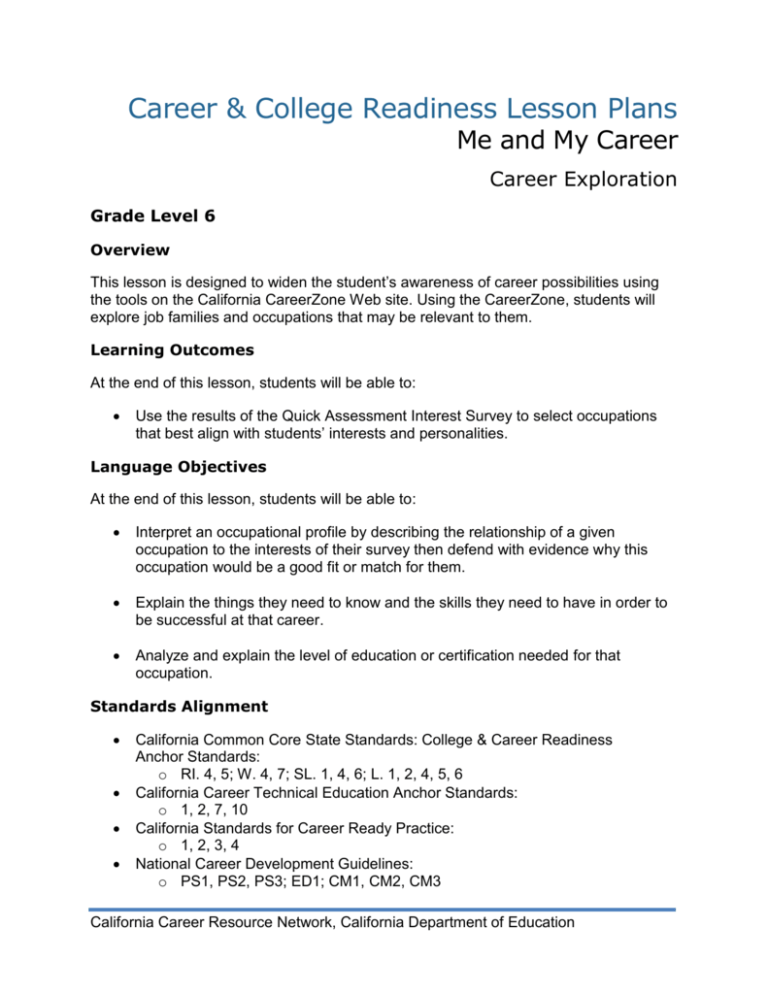
Career & College Readiness Lesson Plans Me and My Career Career Exploration Grade Level 6 Overview This lesson is designed to widen the student’s awareness of career possibilities using the tools on the California CareerZone Web site. Using the CareerZone, students will explore job families and occupations that may be relevant to them. Learning Outcomes At the end of this lesson, students will be able to: Use the results of the Quick Assessment Interest Survey to select occupations that best align with students’ interests and personalities. Language Objectives At the end of this lesson, students will be able to: Interpret an occupational profile by describing the relationship of a given occupation to the interests of their survey then defend with evidence why this occupation would be a good fit or match for them. Explain the things they need to know and the skills they need to have in order to be successful at that career. Analyze and explain the level of education or certification needed for that occupation. Standards Alignment California Common Core State Standards: College & Career Readiness Anchor Standards: o RI. 4, 5; W. 4, 7; SL. 1, 4, 6; L. 1, 2, 4, 5, 6 California Career Technical Education Anchor Standards: o 1, 2, 7, 10 California Standards for Career Ready Practice: o 1, 2, 3, 4 National Career Development Guidelines: o PS1, PS2, PS3; ED1; CM1, CM2, CM3 California Career Resource Network, California Department of Education Career Exploration Me and My Career International Society for Technology in Education Standards: o 1, 4, 5, 6 English Language Development Standards: Part I: 1, 2, 5, 6, 9, 10 Part II: 1–4, 6, 7 Materials 1. Computers with Internet access for students 2. Computers with Internet access and projection capability for instructor 3. Projector 4. Handouts Holland Codes (p. 7) Me and My Career (p. 8) 5. Online Resource California CareerZone http://www.cacareerzone.org Academic Vocabulary Associate degree: is a college degree awarded by a California community college upon completion of a course of study. Traditionally, Associate degrees require two years of full-time education to achieve. Baccalaureate (Bachelor's) degree: is a degree received upon completion of a program of study at a university or college. Traditionally, a baccalaureate or bachelor's degree requires four years of full-time education. Career: is the body of work—all jobs and occupations—and life experiences that a person experiences during his or her lifetime. Certificate: is a document issued by an educational training provider to a student who completes a training program. It serves to provide proof of training. Graduate degree: is a master's or doctoral degree awarded upon completion of a program of study. A student must have a bachelor's degree before entering a graduate program. A graduate degree is necessary for many professions, such as a doctor, lawyer, or professor. Job: is a specific position in which a person is employed. California Career Resource Network, California Department of Education 2 of 6 Career Exploration Me and My Career Occupation: is a cluster of jobs with common characteristics that require similar skills (e.g., photographer). Activity Students will go to the California CareerZone Web site and complete the Quick Assessment to help them determine occupations that best match their interests and personality. Students will take notes and then transfer their notes to the “Me and My Career” handout. Lesson Procedures 1. Review the academic vocabulary with students and distribute the Holland Codes handout. Student may be familiar with the Holland Codes if they have completed the Career Portfolio lesson, if not, review the Holland Codes with the class. 2. Using a projector, show students how to get to the California CareerZone Web site (link in Materials section) using the following steps: i. Go to the home page, under Assess Yourself, click on “Begin Assessment”. ii. Click on “Quick Assessment”. iii. Have students select three personal characteristics from the Holland Code wheel. iv. Click “View Results”. v. You are now on the Search Results page. 3. Scroll down to the list of occupations and click on one in order to show students all of the information that will be given about that occupation. 4. Show students the “Me and My Career” handout and explain that the areas on the note-taking guide mirror the CareerZone’s occupational profile page. The student response areas in this handout could be expanded to create a two-sided handout if it looks like the students need more room to respond. 5. Tell students that they should look through the career choices that might interest them and then choose the one that is most appealing to them. 6. Using the occupational profile information for that career, students will complete the “Me and My Career” handout. 7. Students share information about their career with elbow partner or with a small group. After that, have some students share out with the whole class. California Career Resource Network, California Department of Education 3 of 6 Career Exploration Me and My Career Estimated Time One class session Evaluation Students complete the California CareerZone Quick Assessment and the “Me and My Career” handout. IMPORTANT: State and federal laws govern the conditions and limitations for Internet usage by children under the age of 13. Before using the Internet, check your district policies and/or state and federal regulations. California Career Resource Network, California Department of Education 4 of 6 Career Exploration Me and My Career Holland Codes Holland Codes are based on a theory of careers and occupational choices that relate occupational environments to personality types. It was developed by the psychologist John L. Holland. The codes are broken down into the following six areas: Realistic occupations frequently involve work activities that include practical, hands-on problems and solutions. They often deal with plants, animals, and realworld materials like wood, tools, and machinery. Many of the occupations require working outside, and do not involve a lot of paperwork or working closely with others. Investigative occupations frequently involve working with ideas, and require an extensive amount of thinking. These occupations can involve searching for facts and figuring out problems mentally. Artistic occupations frequently involve working with forms, designs and patterns. They often require self-expression and the work can be done without following a clear set of rules. Social occupations frequently involve working with, communicating with, and teaching people. These occupations often involve helping or providing service to others. Enterprising occupations frequently involve starting up and carrying out projects. These occupations can involve leading people and making many decisions. Sometimes they require risk taking and often deal with business. Conventional occupations frequently involve following set procedures and routines. These occupations can include working with data and details more than with ideas. Usually there is a clear line of authority to follow. Source: California CareerZone, http://www.cacareerzone.org/faq/32 California Career Resource Network, California Department of Education Career Exploration Me and My Career Me and My Career Name ________________________________ Date _________________________ Search Results Page Out of the list of occupations on your search results page, what occupation looks the most interesting to you? Why is this occupation good choice for you? What other occupations look like a good match for you? Occupational Profile Page In the occupation that looks most interesting to you, what do people in this occupation do? Write down the section heading and two or three specific things people do. What are some things you need to know to be successful in the job? Write down the section heading and some specific knowledge required. What skills do you need to have for this occupation? Write down the section heading and some specific skills required. What training, education, or certification is needed for this occupation? Write down the section heading and list the training required for this occupation. California Career Resource Network, California Department of Education

